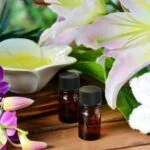Are you considering using aromatherapy during labor? Evidence-based research suggests that aromatherapy can provide a natural and holistic approach to pain relief and relaxation during childbirth. In this article, we will explore the basics of aromatherapy in labor, its history, benefits, types of essential oils used, practical tips and techniques for usage, safety precautions, success stories, and recommendations for integrating aromatherapy into your labor plan.
Aromatherapy has been used for centuries as a natural remedy for various ailments and has gained popularity in the field of maternity care. The use of essential oils during labor has been found to have numerous benefits for both the mother and her birthing experience. Understanding the basics of aromatherapy in labor can help expectant mothers make informed decisions about incorporating this practice into their birth plan.
In this comprehensive guide, we will delve into the origins and traditions of aromatherapy in labor, explore evidence-based research on its benefits, discuss the types of essential oils commonly used for pain relief during childbirth, provide practical tips on how to use aromatherapy effectively, and highlight safety precautions and risk factors to consider. Additionally, we will share real-life success stories from mothers who have experienced the positive effects of incorporating aromatherapy into their labor journey.
Whether you are a first-time mother or considering a natural approach to childbirth, understanding the basics of aromatherapy in labor is essential for making informed decisions about your birthing experience.
History of Aromatherapy in Labour
The use of aromatherapy in labour can be traced back to ancient civilizations, where women utilized the healing properties of essential oils during childbirth. In cultures such as Egypt, Greece, and Rome, aromatic plants and oils were used for their therapeutic benefits in easing labour pains and promoting relaxation during the birthing process. These ancient traditions have laid the foundation for the modern-day practice of aromatherapy in labour.
Origins of Aromatherapy in Ancient Cultures
In ancient Egypt, essential oils such as frankincense and myrrh were commonly used during childbirth to help alleviate pain and support the mother’s emotional well-being. The Greeks also embraced the use of aromatic herbs like lavender and chamomile to provide comfort and relief to women in labour. Similarly, in ancient Rome, essential oils such as clary sage and rosemary were valued for their ability to promote relaxation and ease childbirth discomfort.
Traditional Practices Around the World
Beyond the Mediterranean region, many other cultures have incorporated aromatherapy into their traditional birthing practices. In India, for example, during Ayurvedic childbirth rituals, herbal preparations containing essential oils are often used to soothe laboring mothers. In Japan, the practice of using hinoki (Japanese cypress) oil has been passed down through generations as a natural way to support women during childbirth. These diverse traditions showcase the global significance of aromatherapy in labour throughout history.
As we reflect on these historical practices, it becomes clear that the use of essential oils in childbirth is not a passing trend but rather a time-honored tradition that continues to be valued by many expectant mothers today.
Benefits of Aromatherapy in Labour
Aromatherapy has been gaining popularity as a natural and holistic approach to pain relief during labour. Many women are turning to this alternative method to manage their discomfort and anxiety during childbirth. But what does the evidence-based research say about the benefits of aromatherapy in labour?
Several studies have shown that aromatherapy can effectively reduce feelings of anxiety and stress during labor. A 2016 study published in the Journal of Alternative and Complementary Medicine found that women who received aromatherapy with essential oils reported lower levels of anxiety compared to those who did not receive aromatherapy. Another study in the Journal of PeriAnesthesia Nursing in 2020 indicated that aromatherapy may also help in reducing the perception of pain during labour.
Furthermore, some essential oils used in aromatherapy have been found to have specific benefits for women in labour. For example, lavender oil has been shown to promote relaxation and reduce anxiety, while peppermint oil may help alleviate nausea and improve focus. These findings suggest that using aromatherapy in labour can offer valuable benefits for expectant mothers.
| Research Study | Findings |
|---|---|
| Journal of Alternative and Complementary Medicine (2016) | Aromatherapy reduced anxiety levels during labor |
| Journal of PeriAnesthesia Nursing (2020) | Aromatherapy may reduce the perception of pain during labor |
Types of Essential Oils Used in Aromatherapy for Labour Pain Relief
Aromatherapy in labour has gained popularity in recent years as more and more women seek natural methods for pain relief during childbirth. Essential oils have been used for centuries for their therapeutic properties, and they are now being integrated into labour plans to help manage discomfort and promote relaxation. When it comes to essential oils for labour pain relief, there are several options to consider, each with its own unique benefits and applications.
One of the most popular essential oils used in aromatherapy for labour pain relief is lavender. Known for its calming and soothing properties, lavender oil can help reduce anxiety and stress during childbirth. It is often used in massage or added to a diffuser to create a relaxing atmosphere in the delivery room.
Another commonly used essential oil for labour pain relief is clary sage. This oil is believed to help stimulate contractions and ease menstrual cramps, making it a popular choice for women in early labor. However, it should be used with caution and under the guidance of a qualified aromatherapist or healthcare provider.
Peppermint oil is also frequently used during labor to provide relief from nausea and vomiting. Its refreshing scent can help combat feelings of queasiness that often accompany the later stages of childbirth. Additionally, some women find that inhaling peppermint oil can provide a much-needed energy boost during prolonged labor.
Overall, while essential oils can offer potential benefits during childbirth, it’s important to approach their use with caution and seek guidance from a qualified professional before incorporating them into your birth plan.
| Essential Oil | Benefits |
|---|---|
| Lavender | Calming and soothing properties, reduces anxiety and stress |
| Clary Sage | Stimulates contractions, eases menstrual cramps (use with caution) |
| Peppermint | Relieves nausea and vomiting, provides an energy boost |
How to Use Aromatherapy in Labour
When using aromatherapy in labor, it is important to use it safely and effectively. Here are some practical tips and techniques for incorporating aromatherapy into your labor experience:
- Choose the Right Essential Oils: Select essential oils that are safe for labor and have been shown to provide pain relief and relaxation. Some popular choices include lavender, clary sage, and peppermint.
- Diffusion: Using a diffuser is a common method for aromatherapy in labor. Add a few drops of the chosen essential oil to the diffuser and let the scent fill the room. This can help create a calming environment during labor.
- Topical Application: Another technique is to apply diluted essential oils topically to the skin. This can be done through massage or by adding a few drops of oil to a warm compress.
- Inhalation: Inhaling the aroma directly from the bottle or a cloth infused with essential oil can also provide relief during labor. Simply take deep breaths as needed to experience the benefits of aromatherapy.
- Creating a Relaxing Environment: Use aromatherapy in conjunction with other relaxation techniques, such as dim lighting, gentle music, and comfortable positions. This can enhance the overall effectiveness of aromatherapy during labor.
By following these practical tips and techniques, you can maximize the benefits of aromatherapy in labor and create a soothing atmosphere that supports your birthing experience. Remember to consult with a healthcare professional before using any essential oils, especially if you have any health conditions or concerns.
Aromatherapy for Labour
Understanding the Risks
While aromatherapy has been shown to be generally safe and effective for many women in labor, there are still potential risks and side effects to consider. Some essential oils can cause skin irritation or allergic reactions, so it’s important to perform a patch test before using any new oil.
Additionally, certain essential oils can have an impact on hormonal balance or blood pressure, which could be problematic during labor. It’s crucial to consult with a qualified aromatherapist or healthcare provider before using aromatherapy in labor, especially if you have any preexisting medical conditions.
Safety Precautions for Aromatherapy in Labour
To ensure the safety of both the mother and the baby, it’s important to take certain precautions when using aromatherapy during labor. Essential oils should always be diluted properly before use, as applying them directly to the skin can lead to irritation or sensitization.
It’s also recommended to use a diffuser rather than direct application for a more controlled and diluted release of the aroma. Moreover, pregnant women should avoid using certain essential oils such as clary sage and rosemary until they are in active labor, as these oils may stimulate contractions.
Consultation With Healthcare Providers
Before incorporating aromatherapy into your birth plan, it is crucial to discuss your intentions with your healthcare provider or midwife. They can provide guidance on which essential oils are safe for you and your baby based on your medical history and any existing conditions you may have.
In some cases, they may advise against using aromatherapy altogether due to specific risk factors. By having an open dialogue with your healthcare provider, you can make informed decisions about utilizing aromatherapy during labor while prioritizing safety.
By being aware of potential risks and taking necessary precautions, women can effectively incorporate evidence-based aromatherapy into their birthing experience while promoting a safe and positive environment for themselves and their babies.
Success Stories
There are countless success stories from women who have used aromatherapy during labour, reporting positive experiences and pain relief. Many women have found that the use of essential oils such as lavender, peppermint, and chamomile during labour has helped to lower stress levels and reduce anxiety. One particular study published in the Journal of Alternative and Complementary Medicine found that inhaling a lavender essential oil blend significantly reduced the perception of labor pain intensity.
For example, Lisa, a mother of two, shared her experience using aromatherapy during labour. She found that the soothing scent of lavender essential oil helped her relax and stay focused during contractions. Another woman, Sarah, reported that using peppermint essential oil in a diffuser helped to alleviate her nausea and provided a refreshing sensation during her long hours of labour.
In addition to individual anecdotes, scientific evidence also supports the use of aromatherapy in labour. Research studies have shown that inhaling certain essential oils can lead to physiological changes in the body, such as reducing cortisol levels (the stress hormone) and promoting relaxation. These findings align with the positive experiences shared by many women who have incorporated aromatherapy into their labour plans.
Integrating Aromatherapy Into Your Labour Plan
In conclusion, the use of aromatherapy in labor has been a topic of interest for many expectant mothers seeking natural pain relief and relaxation during childbirth. As explored in this article, the history and traditions of aromatherapy in labor have deep roots, and there is evidence-based research that supports its benefits. From reducing anxiety and stress to managing pain, the use of essential oils in aromatherapy has shown promising results.
When considering integrating aromatherapy into your labor plan, it is important to consult with a qualified healthcare professional or certified aromatherapist. They can provide guidance on the types of essential oils to use, proper techniques for application, as well as safety precautions and any potential risk factors to consider.
Real-life success stories from mothers who have incorporated aromatherapy into their labor experience also offer valuable insights and encouragement for those considering this natural approach. Ultimately, by understanding the basics, history, benefits, practical tips, safety precautions and recommendations outlined in this article, expectant mothers can make informed decisions about whether aromatherapy is a suitable option for their labor plan.
The evidence-based research suggests that when used properly, aromatherapy can be a valuable tool for promoting relaxation and comfort during childbirth.
Frequently Asked Questions
How Effective Is Aromatherapy in Labour?
Aromatherapy has been found to be effective in helping women manage pain and anxiety during labor. The use of essential oils like lavender and peppermint can help create a calming environment, making the experience more manageable.
Is There Any Scientific Evidence for Aromatherapy?
While there is some scientific evidence supporting the benefits of aromatherapy, more research is needed to fully understand its effects on labor. Some studies have shown positive outcomes in terms of pain management and emotional well-being, but further research is necessary.
Can I Use Essential Oils During Labor?
Essential oils can be used during labor, but it’s important to do so cautiously and under the guidance of a trained professional. Certain essential oils may not be safe for use during pregnancy or labor, so it’s crucial to consult with a healthcare provider before using them.

Are you looking for a natural way to improve your health and wellbeing?
If so, aromatherapy may be the answer for you.





